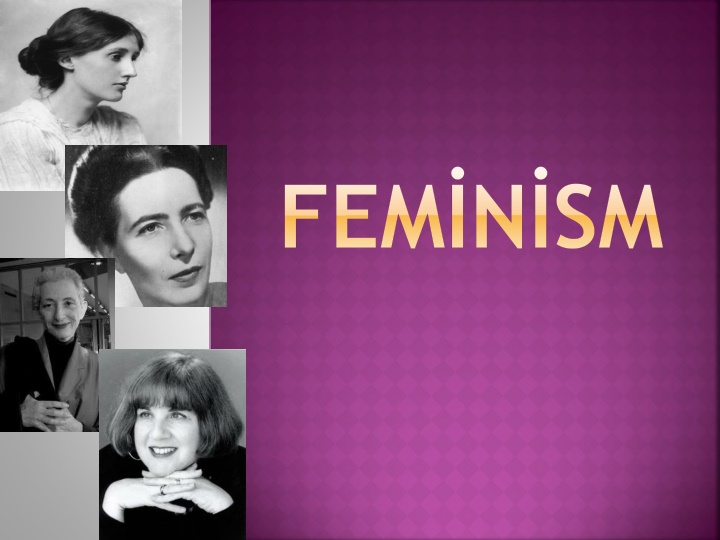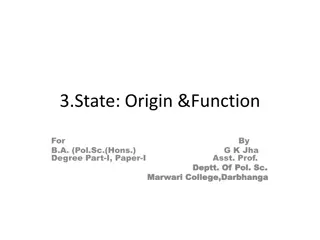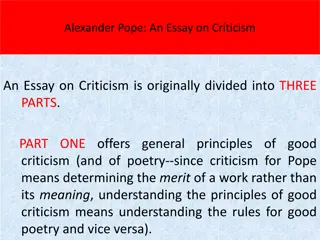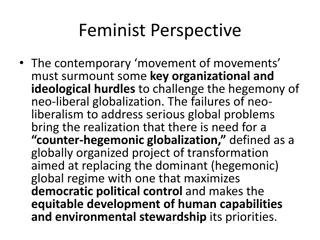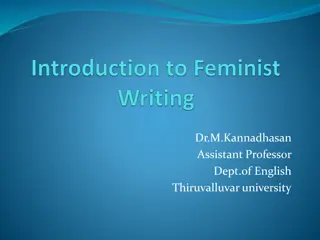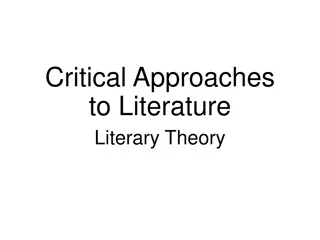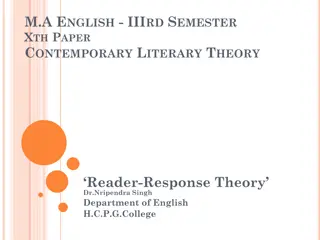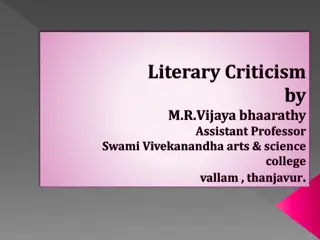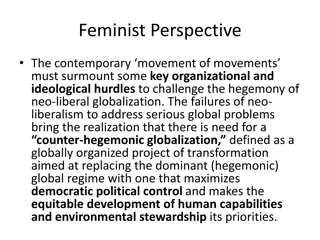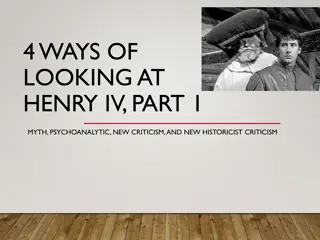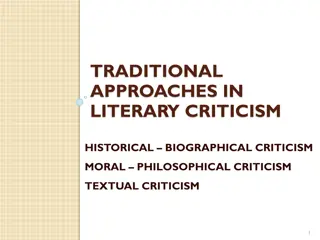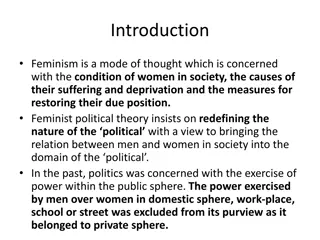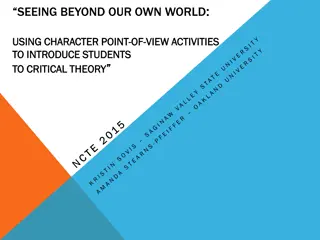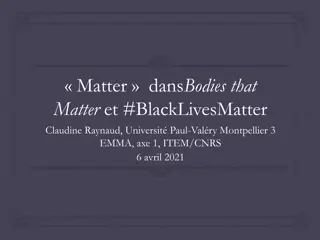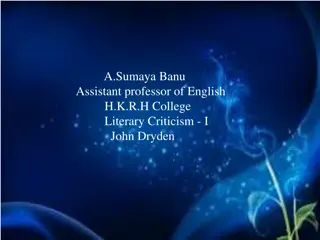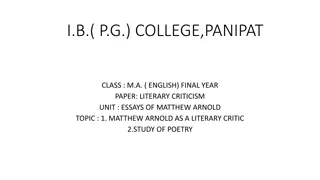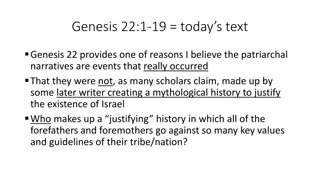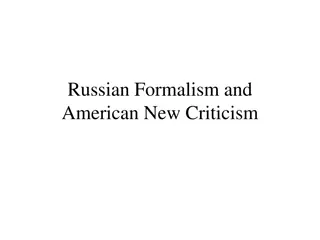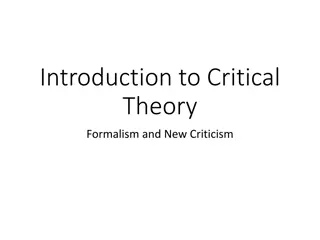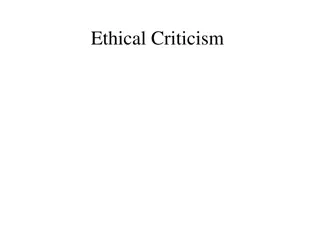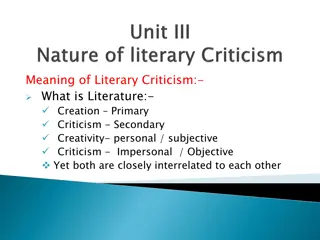Evolution of Feminist Literary Criticism: Challenging Patriarchal Ideals Through History
Feminist literary criticism challenges historical patriarchal views in literature from ancient Greek beliefs to modern writings. The roots of prejudice against women have been deeply embedded in Western culture, with notable works like Mary Wollstonecraft's "A Vindication of the Rights of Women" pioneering the fight for gender equality. This critical perspective advocates for interpreting literature without bias based on race, class, or gender, highlighting the need for diverse and inclusive representations in literary analysis.
Download Presentation

Please find below an Image/Link to download the presentation.
The content on the website is provided AS IS for your information and personal use only. It may not be sold, licensed, or shared on other websites without obtaining consent from the author.If you encounter any issues during the download, it is possible that the publisher has removed the file from their server.
You are allowed to download the files provided on this website for personal or commercial use, subject to the condition that they are used lawfully. All files are the property of their respective owners.
The content on the website is provided AS IS for your information and personal use only. It may not be sold, licensed, or shared on other websites without obtaining consent from the author.
E N D
Presentation Transcript
Patriarchal vision that has been established in the literary Canon: Plato thanks the gods for two blessings: that he had not been born a slave and that he had not been born a woman. Plato (c. 427-c. 347 b.c.e.) The male is by nature superior, and the female inferior; and the one rules and the other is ruled. Woman "is matter, waiting to be formed by the active male principle....Man consequently plays a major part in reproduction; the woman is merely the passive incubator of his seed. Aristotle (384-322 b. c. e.)
Nature intended women to be our slaves.. . They are our property.. .. What a mad idea to demand equality for women! Napoleon Bonaparte (1769-1821) Jane Austen is entirely impossible to read. It seems a great pity that they allowed her to die a natural death. Mark Twain (1835-1910) Educating a woman is like pouring honey over a fine Swiss watch. It stops working. Kurt Vonnegut, Jr. (1922 )
Feminist literary criticism challenges such patriarchal statements with their accompanying male-dominated, philosophical assumptions and such gender-biased criticism. Feminist criticism argues that literature should be free from such biases because of race, class, or gender, and provides a variety of theoretical frameworks and approaches to interpretation that values each member of society.
HSTORCAL DEVELOPMENT
According to feminist criticism, the roots of prejudice against women has long been embeded in Western culture. The Ancient Greek, for instance, declare the male to be the superior and the female inferior. Some scholars believe that the first major work of feminist criticism challenging male voices was that authored by Christine de Pisan in the fourteenth century, Epistre au Dieu D'amours (1399). In this work, Pisan critiques Jean de Meun's biased representation of the nature of woman in his text Roman de La Rose. In another work, La Citedes Dames(1405), Pisan declares that God created men and women as equal beings.
But it was not until the late 1700s that voice arose in opposition to patriarchal beliefs and statements. The first major published work that acknowledges an awareness of women's struggles for equal rights is regarded as A Vindication of the Rights of Women(1792) authored by Mary Wollstonecraft (1759-1797) through which she asserts that women should define for themselves what it means to be a woman .
It was not until the Progressive Era of the early 1900s, however, that major concerns of feminist criticism took root. During this time, women gained the right to vote and became prominent activists in the social issues of the day, such as health care, education, politics, and literature, but equality with men in these arenas still remained outside their grasp.
During this period prominent women writers appeared with their works dealing with the perception of woman in the society. Virginia Woolf s A Room of One s Own (1929) vividly portrays the unequal treatment given to women seeking education and alternatives to marriage and motherhood; and Simone de Beauvoir s The Second Sex (1949), has an important section on the portrayal of women in the novels of D.H. Lawrence; Kate Millett s Sexual Politics (1969) points out that gender is constructed by society.
VRGNA WOOLF A WOMAN MUST HAVE MONEY AND A ROOM OF HER OWN IF SHE IS TO WRITE FICTION. In 1919, the British scholar and teacher Virginia Woolf (1882-1941) developed and enlarged Mary Wollstonecraft's ideas, laying the foundation for present-day feminist criticism in her seminal work A Room of One's Own(1929). Women, Woolf declares, must reject the social construct of femaleness and establish and define for themselves their own identity. To do so, they must challenge the prevailing, false cultural notions about their gender identity and develop a female discourse that will accurately portray their relationship "to the world of reality and not to the world of men."
Societal and world calamities such as the Great Depression of the 1930s and World War II in the 1940s, however, changed the focus of humankind's attention and delayed the advancement of these feminist ideals.
SMONE DE BEAUVOR ONE IS NOT BORN A WOMAN,BUT RATHER BECOMES ONE After World War II and the 1949 publication of The Second Sex by the French writer Simone de Beauvoir (1908-1986), feminist concerns once again surfaced. Like Woolf before her, Beauvoir believes that men define what it means to be human, including what it means to be female. Since the female is not male, Beauvoir maintains, she becomes the Other, an object whose existence is defined and interpreted by the dominant male.
Beauvoir believes that women must break the bonds of their patriarchal society and define themselves if they wish to become a significant human being in their own right, and they must defy male classification as the Other. Beauvoir insists that women must see themselves as autonomous beings. Women, she maintains, must reject the societal construct that men are the subject or the absolute and women are the Other.
KATE MLLETT With Millett's publication of Sexual Politics in 1969, a new wave of feminism begins. Millett is one of the first to challenge the ideological characteristics of both the male and the female. She argues that a female is born, but a woman is created. In other words, one's sex is determined at birth, but one's gender is a social construct created by cultural norms.
Boys, for example, should be aggressive, self- assertive, and domineering, but girls should be passive, meek, and humble. Such cultural expectations are transmitted through media, including television, movies, songs, and literature. Conforming to these prescribed sex roles dictated by society is what Millett calls sexual politics, or the operations of power relations in society.
FEMINISM IN THE 1960s, 1970s AND 1980s The feminist literary criticism of today is the direct product of the women s movement of 1960s. It realized the significance of the images of women depicted by literature, and saw it as vital to combat them and question their authority and coherence.
In 1963, two works help bring feminist concerns into the public arena: American Women, edited by Frances Bagley Kaplan and Margaret Mead, and The Feminine Mystique by Betty Freidan. American Women details the great inequality between men and women in the workplace, education, and society as a whole.Whereas, Friedan articulated and helped popularize two central questions of feminist criticism that soon became popular: "A woman has got to be able to say, and not feel guilty, 'Who am I, and What do I want out of life?'
Feminists pointed out, for instance, that in 19th century fiction very few women work for a living, unless they are driven to it by dire necessity. Instead, the focus of interest is on the heroine s choice of marriage partner, which will decide her ultimate social position and exclusively determine her happiness and fulfilment in life, or her lack of these.
During this time and throughout the 1970s, feminist theorists and critics began to examine the traditional literary canon, discovering copious examples of male dominance and prejudice that supported Beauvoir's and Millett's assertion that males consider the female "the Other."
Stereotypes of women abounded in the canon: Women were sex maniacs, goddesses of beauty, mindless entities, or old spinsters. Similarly, the roles of female, fictionalized characters were often limited to minor characters whose chief traits reinforced the male's stereotypical image of women. Female theorists, critics, and scholars such as Woolf and de Beauvoir were simply ignored, their writings seldom, if ever, referred to by the male crafters of the literary canon.
Thus, in feminist criticism in the 1970s the major effort went into exposing what might be called the mechanism of patriarchy, that is, the cultural mind-set in men and women which perpetuated sexual inequality. Critical attention was given to books by male writers in which influential or typical images of women were constructed.
ELANE SHOWALTER A leading voice of feminist criticism throughout the late 1970s and through the next several decades is that of Elaine Showalter. In her text A Literature of Their Own(1977), Showalter chronicles three historical phases of female writing: the feminine phase (1840-1880), the feminist phase (1880-1920), and the female phase (1970-present).
FEMNNE PHASE (1840-1880) Writers such as Charlotte Bronte, George Eliot, and George Sand accepted the prevailing social constructs that defined women. Accordingly, these authors wrote under male pseudonyms so that their works, like their male counterparts, would first be published and then recognized for their intellectual and artistic achievements.
FEMNST PHASE (1880-1920) During the "feminist" or second phase, female writers helped dramatize the plight of the "slighted" woman, depicting the harsh and often cruel treatment of female characters at the hands of their more powerful male creations.
FEMALE PHASE (1920-PRESENT) In the third or "female" phase, female writers reject both the feminine social constructs prominent during the "feminine" phase and the secondary or minor position of female characters that dominated the "feminist" phase.
Showalter observes that feminist theorists and critics now concerned themselves with developing a peculiarly female understanding of the female experience in art, including a feminine analysis of literary forms and techniques. Such a task necessarily includes the uncovering of misogyny in texts, a term Showalter uses to describe the male hatred of women.
In her influential essay "Toward a Feminist Poetics" (1997), Showalter asserts that feminist theorists must "construct a female framework for analysis of women's literature to develop new models based on the study of female experience, rather than to adapt to male models and theories," a process she names gynocriticism.
Gynocriticism provides critics with four models that address the nature of women's writing: the biological, the lin- guistic, the psychoanalytic, and the cultural. The biological model emphasizes how the female body marks itself upon a text by providing a host of literary images along with a personal, intimate tone. The linguistic model addresses the need for a female discourse, investigating the differences between how women and men use language.
The psychoanalytic model analyzes the female psyche and demonstrates how such an analysis affects the writing process, emphasizing the flux and fluidity of female writing as opposed to male writing's rigidity and structure. The last of Showalter's models/the cultural model, investigates how society shapes women's goals, responses, and points of view.
eclectic drawing upon the findings and approaches of other kinds of criticism- Marxism, structuralism, linguistics, so on. It switched its focus from attacking male versions of the world to exploring the nature of female world and outlook and reconstruction the lost or suppressed records of female experience. Attention was switched to the need to construct a new canon of women s writing by rewriting the history of the novel and of poetry in such a way that neglected women writers were given new prominence. In the 1980s, feminism became much more
In conclusion, Feminist theorists and critics want to correct erroneous ways of thinking. Women, they declare, are individuals, people in their own right; they are not incomplete or inferior men. Despite how frequently literature and society have fictionalized and stereotyped females as angels, bar maids, bitches, whores, brainless housewives, or old maids, women must define themselves and articulate their roles, values, aspirations, and place in society.
Rethink the canon, aiming at the rediscovery of texts written by women. Revalue women s experience. Examine representations of women in literature by men and women. Challange representations of women as Other , as lack , as part of nature . Examine power relations which obtain in texts and in life, with a view to breaking them down, seeing reading as a political act, and showing the extent of patriarchy. Recognise the role of language in making what is social and constructed seem transparent and natural .
Raise the question of whether men and women are essentially different because of biology, or are socially constructed as different. Explore the question of whether there is a female language, an ecriture feminine, and whether this is also available to men. Reread psychoanalysis to further explore the issue to female and male identity. Question the popular notion of the death of the author, asking whether there are only subject positions constructed in disourse , or whether, on the contrary, the experience is central. Make clear the ideological base supposedly neutral or mainstream literary interpretations.
QUESTONS FOR ANALYSS Is the author male or female? Is the text narrated by a male or female? What types of roles do women have in the text? Are the female characters the protagonists or secondary and minor characters? Do any stereotypical characterizations of women appear? What are the attitudes toward women held by the male characters?
What is the author's attitude toward women in society? How does the author's culture influence her or his attitude? Is feminine imagery used? If so, what is the significance of such imagery? Do the female characters speak differently than the male characters? In your investigation, compare the frequency of speech for the male characters to the fre- quency of speech for the female characters.
SHAKESPEARES SONNET 144 Two loves I have of comfort and despair, Which like two spirits do suggest me still; The better angel is a man right fair, The worser spirit a woman colour'd ill. To win me soon to hell, my female evil Tempteth my better angel from my side, And would corrupt my saint to be a devil, Wooing his purity with her foul pride. And whether that my angel be turn'd fiend Suspect I may, but not directly tell; But being both from me, both to each friend, I guess one angel in another's hell: Yet this shall I ne'er know, but live in doubt, Till my bad angel fire my good one out.
FEMNST CRTCSM OF SHAKESPEARE S SONNET 144 In Sonnet 144, which is the only sonnet bringing the young boy and the Dark Lady together in the sonnet sequence, he portrays the Dark Lady as worser spirit , female evil and bad angel . In this sense, the Dark Lady is dark in terms of not only her skin color but also her personality. For the lover/poet, she is a wicked seductress that steals this beloved young man.
The sonnet explicitly shows that the lover/poet prefers the love and companionship of the young man to the love of the Dark Lady, thus, he blames the Dark Lady for the love affair between her and the fair young man. Within this context, like other sonnet heroines, it is the Dark Lady who is attributed to all evil traits. As is the case with Eve who leads Adam to fall from the heaven, the Dark Lady is responsible of all the troubles of the lover/poet taking the young boy to her hell with herself.
FEMNST CRTCSM OF BRONTES JANE EYRE The detailed exploration of a strong female character's consciousness has made readers in recent decades consider Jane Eyre as an influential feminist text. The novel works both as the absorbing story of an individual woman's quest and as a narrative of the dilemmas that confront so many women. In Jane Eyre, Charlotte Bront created a fully imagined character defined by her strength of will. Though Jane is nothing more than an impoverished governess, she can retort to her haughty employer Rochester: "Do you think, because I am poor, obscure, plain, and little, I am soulless and heartless? You think wrong!" (p. 284).
As an adult, Jane faces the romantic prospects of a young woman lacking the social advantages of family, money, and beauty, and therefore especially vulnerable to the allure of admiration and security. By creating two suitors who exemplify opposing threats to Jane's selfhood, Bront dramatizes Jane's internal struggles against competing temptations, and Jane's efforts to resist both St. John Rivers and Rochester. In Jane, Bront gives us a character able to withstand St. John's missionary call to self-immolation in a marriage to serve humanity and Rochester's attempts to persuade her to indulge her sexual and romantic desires at the expense of her own moral code.
Jane Eyre was a representative work reflecting women s call for equality which is explicitly revealed at the end of the novel. In this sense, Jane makes declaration to Rochester: "'I told you I am independent, sir, as well as rich: I am my own mistress'" (458). Her choice of words signals to Rochester (after his long search for a good mistress, in either sense of the word) that she is not his inferior. If she is her "own mistress," then she must be economically dependent on herself alone.Likewise, she marries Rochester when they are on equal terms with Jane s gaining financial independence via inheritance and Rochester s physical disabilities.
